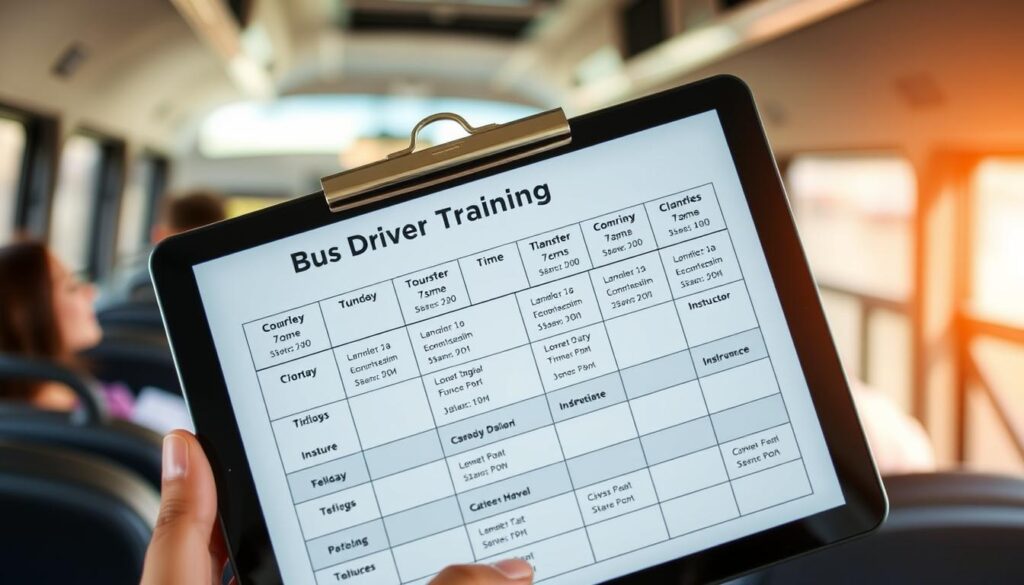Over 150,000 new bus driver positions will open across the U.S. by next year – enough to fill every seat in three NFL stadiums. This surge creates unprecedented opportunities for people seeking stable work with competitive pay averaging $45,660 annually. Best part? Many employers now offer paid training programs, eliminating the need for prior experience.
You’ll need three essentials: a clean driving record, valid license, and proof you meet the 21+ age requirements. The hiring process typically takes four weeks from application to training – faster than most service industry jobs. States like California and New York offer salaries exceeding $54,000 for qualified candidates.
Standout applicants use tools like proven resume templates to highlight safety certifications and customer service skills. Platforms such as RoboApply simplify applications with automated job-matching algorithms and a step-by-step resume builder tailored for transportation roles.
Key Takeaways
- 150,000+ new bus driver jobs projected by 2025 nationwide
- No prior experience needed – paid training provided
- 21+ age requirement with valid driver’s license
- 4-week average hiring timeline from application to training
- Earning potential exceeds $54k in high-demand states
- Specialized resume tools boost interview chances
Crafting a Winning Resume for Tour Bus Driver Jobs
Your resume is your first chance to prove you’re built for passenger safety and smooth operations. Start by framing non-driving roles as relevant experience – hospitality positions show customer care abilities, while delivery jobs demonstrate route planning skills. Employers need complete employment details from the last five years, including explanations for gaps exceeding 90 days.
Build Smarter with Automation
RoboApply’s AI tools transform raw data into polished applications. Their resume builder automatically formats your commercial driver license details and work history to meet transportation industry standards. The built-in grammar checker eliminates errors, while the ATS optimizer ensures your application clears automated screenings used by 83% of fleet operators.
Showcase Your Record Strategically
Highlight clean driving history first in your certifications section. If you have a CDL, list expiration dates and endorsements prominently. For those without formal credentials, emphasize safety training from previous roles. Use tour guide resume templates to structure public-facing experience effectively.
Remember: Employers verify licenses across all states you’ve held them. Disclose every jurisdiction clearly. Keep explanations for violations brief but honest – focus on lessons learned rather than excuses. Proper formatting here builds trust before your interview.
Essential Skills and Experience for Success on the Road
Your success behind the wheel depends on more than technical driving skills. Modern transportation roles demand a unique blend of interpersonal abilities and operational expertise that keeps passengers safe and satisfied.

Customer Service and Driving Record Essentials
Interacting with diverse groups requires polished communication techniques. You’ll regularly explain routes, safety protocols, and local attractions while managing expectations. Handling mobility devices and accessibility needs becomes second nature through targeted training programs.
Maintaining composure during 12-hour shifts separates adequate candidates from exceptional ones. Develop strategies for managing delays, weather challenges, and passenger conflicts without compromising service quality. Physical stamina proves crucial when navigating crowded terminals or assisting with luggage.
Reliability forms the foundation of every successful career in this field. Employers prioritize candidates who demonstrate punctuality through consistent attendance records. Tools like tailored resume templates help showcase these qualities effectively during initial screenings.
Master these core competencies to stand out:
- Conflict resolution techniques for tense situations
- ADA compliance knowledge for accessibility requirements
- Time management strategies for split schedules
- Emergency response preparedness training
How to Land a Tour Bus Driver Job in 2025
Navigating transportation credentials starts with knowing what’s required before you apply. Many employers now handle licensing steps during onboarding, but your preparation determines how quickly you progress.
CLP Acquisition Made Simple
You don’t need a CDL to start the process. Begin with a Commercial Learner’s Permit (CLP) by passing three exams:
- General knowledge test (covers road rules)
- Passenger endorsement exam (safety protocols)
- Air brake certification (equipment operation)
Study materials like state DMV manuals and current job openings often list preferred prep resources. Document three years of driving history clearly – employers verify gaps exceeding 90 days.
Training That Pays Off
Paid programs cover essential skills:
- Pre-trip vehicle inspections
- Maneuvering large vehicles
- Real-road testing scenarios
Companies typically provide training vehicles and cover exam fees. If transferring an out-of-state commercial driver license, check reciprocity agreements. Your employer’s training certificate becomes your golden ticket to full certification.
Those updating existing credentials should review application strategies for seamless transitions between roles. Keep your state-issued driver license current – expired credentials delay the entire process.
Navigating the Step-by-Step Hiring Process
Understanding each phase of the hiring journey prepares you for success. Most transportation companies follow a structured nine-stage system to evaluate candidates thoroughly while maintaining efficiency.

From Application to Online Assessments
Begin by creating a detailed profile through the employer’s portal. This initial application requires:
- Complete work history for the past five years
- Responses to situational screening questions
- Upload of your commercial learner’s permit
You’ll receive a 15-minute assessment within 48 hours. Treat this like a road test – find quiet space and eliminate distractions. Some transit authorities like Metrolinx use pattern-based questions to gauge decision-making skills.
Interview Scheduling and Reference Checks
The 2.5-hour main interview explores your understanding of split shifts and safety protocols. Prepare to discuss:
- Strategies for managing 12-hour routes
- Experience with ADA-compliant vehicles
- Approach to emergency scenarios
Reference checks require four contacts from recent supervisors. Notify them in advance using templates similar to flight attendant reference preparation guides. Most employers complete this phase within seven business days.
After passing these stages, you’ll receive a contingent offer pending medical exams and background checks. Successful candidates typically start training within three weeks of their final offer.
Mastering the Interview and Assessment Stages
Your interview performance determines whether you’ll navigate city streets or stay parked in the applicant pool. Expect scheduling notifications within 7-14 days after submitting materials. Most transportation companies use multi-phase evaluations to assess both technical knowledge and interpersonal skills.
Pre-Screening via Zoom and In-Person Interviews
Virtual meetings often serve as your first checkpoint. Prepare three key stories demonstrating conflict resolution, schedule flexibility, and safety prioritization. Interviewers frequently ask:
- “Describe handling an angry passenger during delays”
- “Explain your approach to split shifts”
- “Share your method for pre-trip inspections”
Research the company’s service routes and training academy structure beforehand. One candidate secured their role by asking: “How does your mentorship program support new drivers during their first 90 days?” This showed engagement with career development opportunities.
Address employment gaps directly using the SAR method (Situation-Action-Result). For example: “During my two-month career break, I completed defensive driving courses to refresh my skills.” Always link past experiences to future performance.
Practice discussing availability using real scenarios: “I successfully managed rotating shifts at my previous role, including holiday weekends.” Highlight customer service philosophy through specific examples rather than vague statements.
Understanding Bus Driver Training and Work Schedules
Your journey begins with structured preparation that combines classroom learning and real-world practice. Most programs follow a phased approach to build confidence behind the wheel while meeting federal safety standards.

Training Phases and CDL Permit Requirements
The first eight weeks focus on core competencies. You’ll practice defensive maneuvers in controlled environments and master pre-trip inspections. Emergency response drills prepare you for scenarios like mechanical failures or medical emergencies.
Weeks six through eight shift to route memorization. Expect daily quizzes on street names, timing points, and passenger loading zones. This phase culminates in supervised street operations where you’ll apply knowledge under real traffic conditions.
Split Shifts and Daily Scheduling Insights
Peak travel times shape most schedules. Morning and afternoon rush hours require split shifts with midday breaks. A typical day might look like:
- 5:00-10:00 AM: High-density commuter routes
- 10:30 AM-3:00 PM: Off-peak break period
- 3:30-6:30 PM: School activity/special event shuttles
New drivers often work variable assignments until gaining seniority. Use tools like customizable schedule templates to manage rotating shifts effectively. Most companies limit continuous driving to 10 hours with mandatory rest periods between split segments.
Pro tip: Track your hours using mobile apps during training. This habit helps anticipate schedule demands while demonstrating time management skills to supervisors.
Boost Your Application with RoboApply's Tools and Features
Maximize your job search efficiency with cutting-edge tools designed for modern applicants. RoboApply’s platform streamlines every phase of the hiring process, giving you an edge in competitive markets. Their AI resume builder transforms raw data into polished applications that meet transportation industry standards, while the ATS optimizer ensures your materials pass automated screenings used by 83% of employers.
Smart Automation for Faster Results
Save hours with the auto-apply Chrome extension, which submits applications across multiple job search engines while you prepare for interviews. Track progress through the four-week hiring timeline using the dashboard – it shows which companies reviewed your materials and when to follow up. The outreach CRM organizes employer communication, scheduling reminders for key calls and emails.
Polish every interaction using the built-in grammar checker, ensuring error-free applications and professional follow-ups. For interview prep, access practice questions tailored to transportation roles through RoboApply’s coaching module. These tools work together like a well-tuned engine – automate repetitive tasks while focusing energy on mastering route knowledge and safety protocols.
New users often secure interviews within 30 days by combining these features with strategies from industry-specific resume guides. Remember: Quick responses to employer requests keep your application moving forward. Set email alerts and check your dashboard daily during active job searches.
FAQ
What commercial driver license requirements apply to tour bus roles?
You’ll need a valid Class A or B CDL with passenger endorsement. Most states require three years of clean driving history and a DOT physical exam. Start the licensing process at least six weeks before applying to account for testing wait times.
How can I make my resume stand out for tour bus positions?
Highlight safety certifications, customer service experience, and route planning skills. Use RoboApply’s AI builder to optimize for keywords like “passenger management” and “schedule adherence.” Include measurable achievements like “Maintained 100% on-time performance over two peak seasons.”
What interview questions should I prepare for?
Expect scenario-based questions like “How would you handle a medical emergency onboard?” and “Describe resolving a passenger conflict.” Practice STAR method responses emphasizing safety protocols and customer service resolutions from past driving roles.
How long does tour bus driver training typically last?
Most companies run three-week programs combining classroom instruction and road training. You’ll need a valid CDL permit before starting. Training often includes navigation software practice and company-specific safety procedures.
What split shift schedules are common in this field?
A> Many tour operators use morning/evening split shifts during peak seasons (summer/holidays). Typical days involve 4 AM departures, midday breaks, and evening returns. Discuss schedule flexibility upfront – some companies offer guaranteed 8-hour rest periods between shifts.
Can RoboApply tools help with multiple applications?
A> Yes. The Auto-Apply Chrome Extension submits applications to 50+ job boards in one click. The ATS Optimizer ensures your resume passes screening systems by aligning with terms like “pre-trip inspections” and “electronic logging device experience.”
What customer service skills are most valued?
A> Employers prioritize conflict resolution, multilingual abilities, and accessibility awareness. Showcase examples like assisting elderly passengers or coordinating with tour guides. Consider including First Aid/CPR certifications to demonstrate emergency preparedness.
How does the CDL permit process work?
A> First pass written exams at your state’s DMV (general knowledge + passenger transport). Then complete behind-the-wheel training – many technical schools offer accelerated programs. Final road tests assess skills like alley docking and passenger loading procedures.
What’s the typical hiring timeline?
A> From application to job offer usually takes two to four weeks. After submitting required documents (driving abstract, drug screen), expect one week for pre-employment assessments, then interviews within three business days. Reference checks often finalize within 48 hours.
How should I prepare for peak season hiring?
A> Update all certifications 60 days before summer/winter peaks. Use RoboApply’s Job Tracker to monitor application windows. Highlight experience with high-volume routes or event transportation in your cover letter. Many companies start onboarding six weeks before seasonal demand spikes.

















